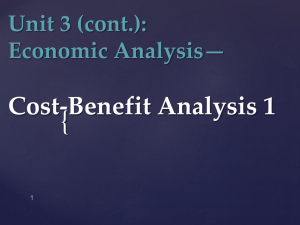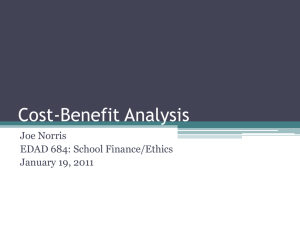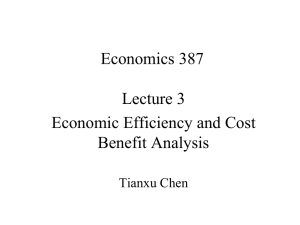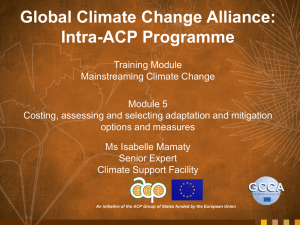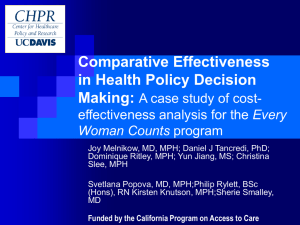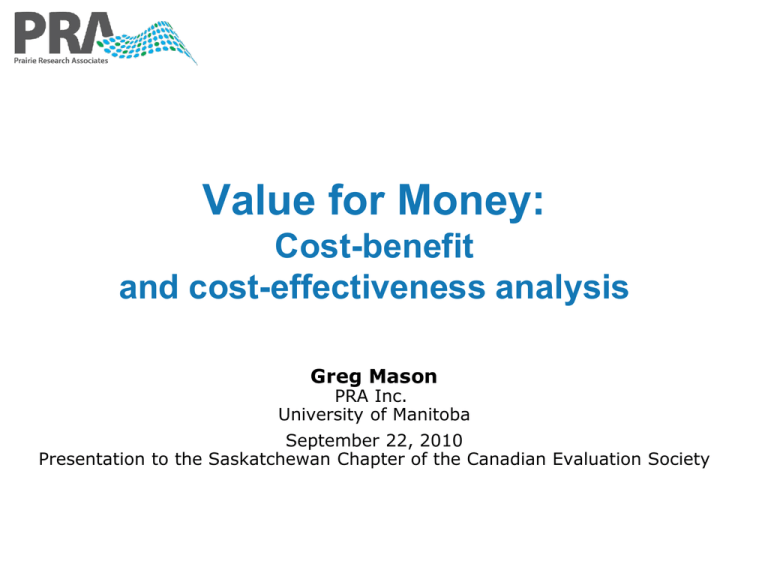
Value for Money:
Cost-benefit
and cost-effectiveness analysis
Greg Mason
PRA Inc.
University of Manitoba
September 22, 2010
Presentation to the Saskatchewan Chapter of the Canadian Evaluation Society
Disclaimer
Cost-benefit and cost-effectiveness analysis are decision
aids; they are not the decision. These methods can help
organize decisions and may reveal both hidden benefits and
hidden costs, but the outputs from this method must not be
the only input into a policy decision.
Any decision on a program, policy, or investment will always
involve questions of ethics, intrinsic values, political
considerations, etc.
The devil is in the details and the assumptions.
1
Goals of the workshop
• This workshop introduces the economic perspective in evaluating
public programs and policies.
• The emphasis is on measurement of value for money using costbenefit analysis (CBA), cost-effectiveness analysis (CEA), and, to
some extent, cost-utility analysis (CUA).
• The workshop will discuss:
– The measurement of net impact
– Attribution of outcomes to the program
– Accurate costing along the results chain (activities, outputs, and
outcomes)
• Two examples will be presented in detail:
– Training single parents on social assistance (retrospective CBA)
– Vaccination of girls against HPV as a way to prevent eventual cervical
cancer (prospective CBA)
2
Morning: Overview of main concepts
• Value for money
– Rationale and relevance
– Defining the scope of government
– The results chain: Outputs and outcomes
• Foundations of decision-making
– CEA (Cost-effectiveness analysis)
– CUA (Cost-utility analysis)
– CBA (Cost-benefit analysis)
• Measuring costs
• Measuring outcomes
• CEA and CBA compared
3
Afternoon: Applications
• Three important problems in CBA
– Valuing intangibles (quality of life)
– Obtaining "objective" measures of value (double counting)
– Measuring the impacts of programs on income and wealth (fairness)
• Time value of money
• Case study 2 – Vaccinating Grade 6 girls against HPV (to prevent
cervical cancer)
– Nature of the program
– Projecting incidence of cervical cancer (20-year forecast)
– The analysis framework
– Limitations and critique
• Case study 1 – Taking Charge: a training and job transition program
for single parents on social assistance
– Overview of the program measuring net impacts
– The analysis framework
– Results
– Limitations and critique
4
Value for money
5
Core issues to be addressed in evaluations (1)
• Relevance issues
– Issue 1 - Continued need for the program: Assessment of
the extent to which the program meets a demonstrable need
and is responsive to the needs of Canadians.
– Issue 2 - Alignment with government priorities:
Assessment of the linkages between program objectives and
(i) federal government priorities and (ii) departmental
strategic outcomes.
– Issue 3 - Alignment with federal roles and
responsibilities: Assessment of the roles and responsibilities
of the federal government in delivering the program.
Source: Treasury Board of Canada. Directive on the Evaluation Function
(Annex A) April 2009.
6
Core issues to be addressed in evaluations (2)
• Performance issues (effectiveness, efficiency, and
economy)
– Issue 4 - Achievement of expected outcomes:
Assessment of progress toward expected outcomes (including
immediate, intermediate, and ultimate outcomes), with
reference to performance targets and program research,
program design, including the linkage and contribution of
outputs to outcomes.
– Issue 5 - Demonstration of efficiency and economy:
Assessment of resource utilization in relation to the production
of outputs and progress toward expected outcomes.
Source: Treasury Board of Canada. Directive on the Evaluation Function (Annex
A) April 2009.
7
Value for money can be defined as:
• Relevance – Are we doing the right thing in the right way?
– Program addresses a demonstrable need, is within the scope of
government capacity, and responds to citizens’ wishes.
• Performance – Are we achieving value?
– Economy: Are taxpayer resources well-utilized?
– Efficiency: Are program outputs (services and products) achieved in
an affordable manner?
– Effectiveness: Are the costs of achieving program outcomes
minimized?
Adapted from Treasury Board Secretariat of Canada
http://www.tbs-sct.gc.ca/eval/ppt/dec06-001/vfmp-por_e.asp
8
Relevance
Relevance (need) emerges in two ways:
– Consumers validate the demand for goods and services in the
marketplace (private goods).
– Government determines needs that the public sector may legitimately
provide (government provision of private and public goods).
• Private and public goods
– Private goods allow all of the benefits/costs to be consumed
(internalized) by the consumer.
– Public goods have external benefits and costs that cannot be
internalized (i.e., externalities exist); there is no incentive for private
provision.
• Merit goods/services are offered by government or charities
based on ethical concepts (e.g., National Child Benefit).
9
Why does government exist?
Three main rationales for public sector action:
–
–
–
Market failure (consumer ignorance of mortgages, pollution)
Externalities (public goods and bads)
Distributional unfairness (poverty)
1. Market failure typically evokes a regulatory response (e.g.,
consumer education, fair lending laws, securities regulation).
2. Public goods encourage government to supplement private
sector provision of a good or service (e.g., subsidization of crop
insurance, subsidization of vaccines, public education).
3. Distributional fairness can result in regulatory, direct provision
of a service, or direct cash transfer.
–
–
–
Laws regarding usury, anti-discrimination legislation
Public housing
National Child Benefit, progressive tax, GST rebate for lower-income
households
10
Definition of government initiatives
• Social marketing to promote a goal (articulation of goal or
intent; guidance on preferred behaviour)
• Expenditures on goods and services
Direct resource commitments on goods (public housing, vaccination)
Direct resource commitments on services (consumer information,
training)
Tax expenditures (tax deductions and credits awarded to citizens and
businesses to behave, spend, invest, etc.)
Grants/contributions/contracts to third parties to perform services
• Legislation is a general framework for how citizens conduct
themselves (smoking bans, criminal code) and requires political
assent.
• Regulation modifies elements of legislation (changes to the speed
limit) and can be completed by administrative fiat.
11
Performance is measured along the
results chain
Activities
Outputs
Economy
Efficiency
Cost
activities
Cost to
to complete
complete activities
(e.g., Staff
staff time
(E.g.,
timeper
perclient
client
assessed)
assessed)
Cost per client trained
(E.g.,
Totaltraining
trainingcosts
costs
(e.g., total
divided
dividedby
bygraduates)
graduates)
Cost per client trained
Immediate
outcomes
Longer-term
outcomes
(Typically within a year)
(Up to 15 years)
Effectiveness
Cost
per client
clientthat
thatbecomes
becomesemployed
employed
Cost per
(e.g., total
costs divided
number
(E.g.,program
Total program
costs by
divided
by that
maintain
employment
for
specified
time)
number that maintain employment for
specified time)
12
Agri-environmental Programming
Agricultural
Extension
Final Assistance
Inputs/Operations/
Activities
· Creation of
research grants
· Development of
research projects
Inputs/Operations/
Activities
· Creation of media
· Development of
seminars
Inputs/Operations/
Activities
· Development of
cost-shared
programs
Outputs
Increased
awareness
Applications
completed
Adoption of
BMPs
Increased on-farm
environmental quality
·
·
Program applications
Evaluation procedures
Oversight processes
Lower incidence of water
and soil contamination
Increased bio-diversity
Immediate
Research information
Outputs
·
·
·
Outcomes
·
Seminars
Content for web-site
Media releases
Final
·
·
·
Outputs
Effectiveness
A logic model anchors
the results chain for
each service line
comprising a
program.
Efficiency
Economy
Service lines
Research and
development
13
Foundations of public sector
decision-making
14
Cost-effectiveness ̶ Cost-benefit
Two requirements:
•
Measure the “bang”
•
Measure the “bucks”
Benefit - cost = “bang per buck”
Cost - benefit = “buck per bang”
Cost-effectiveness analysis – What is the cost of achieving
specific outcomes arising from different interventions?
Cost-utility analysis – What is the perceived value of the
outcomes relative to their costs?
Cost-benefit analysis – What is the value of all outcomes (social
and private) in relation to all costs (social and private)?
15
CBA, CEA, and CUA compared
CEA
Outcomes (outputs, inputs)
(actual changes measured in natural units, not $)
Cost of outcome ($)
CUA
Subjective value of outcomes
(subjective value of outcomes - adjusted natural units, not $)
Cost of outcome ($)
CBA
Monetary value of net change to welfare
of all outcomes for all stakeholders ($)
Social cost ($) (tangible and intangible)
16
CBA, CEA, and CUA compared
CBA
CEA
Local – single
output/outcome
CUA
Scope
Global – multiple
outcomes valued
Local – single
output/outcome
Unit of measure
for outcome
Money equivalent Natural
Utility or
perceived value of
outcome
Time frame
Extended
Immediate/shortterm
Immediate/shortterm
Primary decision
purpose
Prospective
Retrospective
Retrospective
Application
Outcomes or
impacts only
Activitiesoutputs-outcomes
Adjusted costeffectiveness
Reference
No reference
needed
At least one
alternative
At least one
alternative
17
CEA
Outputs and outcomes must be strategic
(and valid and reliable)
• Outputs and outcomes should reflect the core goals of the
program.
– An output/outcome selected for CEA should be selected to reflect the
activity of a program. For this reason, outputs often replace outcomes
in cost-effectiveness analysis because they are easier to measure.
• Outputs and outcomes must be strategic.
– A single output/outcome, if used alone, must represent a central goal
of the program.
• Variation in a strategic outcome should correlate with other
results.
– Increases in that output/outcome should also be correlated with other
outcomes.
18
Measuring costs
19
Cost concepts
•
Opportunity cost – the cost of what is given up
–
–
–
The opportunity cost of taking this workshop is the loss in doing
the next best alternative
One of the opportunity costs of going to school is the income that
is foregone
The opportunity cost of mitigating climate change by subsidies for
wind power technologies is the value of the other uses for the
funds
•
Direct costs – the costs of goods and services expended on the
program
•
Indirect cost – the time spent by program participants in
accessing a service (e.g., patient time spent in waiting when
services are restricted)
•
Intangible costs – pain and suffering, morale (not usually
included in a cost-effectiveness analysis)
•
Cost perspectives – individual, institutional, government,
society
20
Most budgets are inadequate for cost analysis
• Budgets and typical accounting statements often do not include all
of the costs associated with a project.
• Most departmental program budgets exclude the cost of
overheads, such as rent and utilities.
• Senior management costs may not be included in the program’s
costs.
• Staff often work on multiple projects.
• Public accounting for capital costs may allocate the entire cost to
one year, or may not include these costs at all.
• A program budget may be a small element of a departmental
budget.
• Two approaches to costing:
– Components
– Activity base
21
Components approach to costing
This can work for projects that have well-identified and
localized costs.
• Identified costs means that no costs are unaccounted.
• Localized costs means that there are no charges pending,
general overheads, or management costs that cannot be
attributed to the program.
Steps:
• Describe each intervention in terms of the resources needed.
• Include only those that are relevant for the intervention to
develop a marginal cost.
• Become very familiar with each intervention and how it
operates.
22
Example of CEA: Programs to reduce truancy
Example – Programs to reduce dropout rates
Program
Total
cost
Dropouts
Dropout
prevented
Cost per
dropout
prevented
Teacher
opinion
A
$13,500
18
17
$794
-
B
$12,750
20
15
$850
+++
C
$7,500
28
7
$1,071
0
35
0
-
Control
+
Adapted from Levin & McEwan, 2001
23
Activity-based costing (ABC)
• Defects in the standard components costing include:
– Inability to identify costs across service lines (programs) within a
unit
– Inclusion of many costs as indirect or overhead costs (not localized
to the program)
– No assignment of large blocks of variable (labour costs) to service
lines (programs)
– Cannot support the calculation of the marginal value of service lines.
• Activity-based costing breaks down costs by service lines and
activity in each service line.
• It allocates labour across activities and then uses proportionality
to distribute fixed/overhead costs among the activities.
24
Stages in ABC
1. Create a process model and sub-models for the organization
2. Identify the service lines and component activities
3. Create time recording process for staff (who complete weekly
reports on time spent in each activity/sub-activity area)
4. Calculate total labour cost (time in an activity multiplied by
wages) for each resource (staff person)
5. Total the cost for each activity to derive a total cost for each
service line
6. Pro-rate indirect costs (rent and other overhead) by service line
cost totals
7. Sum to obtain cost for each service line
25
Decomposition of total costs by resource
and activity
Overheads
Activity 2
Oversight and
management
Activity 1
Development of
research programs
…
+… +
+… +
+… +
Cost of resource 1
in Activity 2
Resource 1
=
Cost of resource 1
in Activity 1
Resource 2
=
Cost of resource 2
in Activity 1
Resource 3
=
Cost of resource 3
in Activity 1
Resource K
=
Cost of resource K
in Activity 1
+… +
Cost of resource
k in Activity 2
Total salary
=
Total salary for
Activity 1
+… +
Total salary for
Activity 2
Overheads
=
Overheads for
Activity 1
+… +
Overheads for
Activity 2
…
Salaries
Research
Total Cost
Activity 1
Cost of resource 2
in Activity 2
Cost of resource 3
in Activity 2
Total Cost
Activity 2
Total Cost
26
Case study: ABC applied to legal aid
• Legal aid services are offered using three models:
–
–
–
Staff model (lawyers and staff are employees of a government agency)
Private lawyers provide the services under a tariff (contract)
Mixed model
• Legal Aid Manitoba uses a mixed model
–
Comparing the cost-effectiveness of staff counsel versus private counsel requires an
accurate costing
• It uses means tests to assess eligibility
–
–
–
Two levels of eligibility exists
Full eligibility (very low income) will impose no costs on clients
Partial eligibility (working poor) requires repayment of certain costs on a time payment plan
• Clients can choose private or staff counsel
–
–
–
Private lawyers will submit invoices for their time according to a tariff schedule
To the fees paid to lawyers must be added processing costs (salaries and overhead)
incurred by legal aid
The costs of staff counsel also must include all salaries and overhead)
27
Example: Process chart for legal aid service line
• One element of legal
aid in Manitoba offers
service on a payment
plan for low-income
residents whose
income exceeds the
eligibility threshold.
• Legal aid uses an
accounts receivable
process to maintain
these payments.
28
Measuring outcomes
29
CEA example –
Vaccination programs for employees
• Outputs include the numbers vaccinated.
• Outcomes include:
– Sick days
– Total number of employees affected
• The program with the lowest cost per vaccination is the most costeffective in terms of outputs.
• The program with the lowest number of sick days per dollar cost is
the most cost-effective in terms of outcomes.
• Key assumption: three programs are essentially similar. No
program has a markedly different profile in terms of adverse
impact, costs imposed on patient, etc.
30
CEA example – Training interventions
A common goal for many training interventions is the return to work.
Typical examples of outcomes include:
• Return to work for six months
• Hours of work after the intervention
• Number of trainees who become employed
• Wages after training
• Post-intervention Employment Insurance benefits avoided
31
CEA example – Early childhood development
• Early evaluations showed major gains in IQ and grade advancement as a
result of early childhood interventions.
• Recent evidence suggests major benefits, including:
– Higher levels of verbal, mathematical, and intellectual achievement (1 – 2 years)
– Greater success at school, including less grade retention and higher graduation
rates (1 – 10 years)
– Higher employment and earnings (15+ years)
– Better health outcomes (1 – 10 years)
– Less welfare dependency (15+ years)
– Lower rates of crime (5 – 15 years)
– Greater government revenues and lower government expenditures (5 – 15
years)
– Intangibles (lower stress on parents, “spread effects” to the peers of the child
and parents)
32
Example – Grants and contributions
• Increasingly used as federal approach to policy because:
– Provincial/municipal governments have increasing constitutional
authority over public services
– Provincial fiscal capacity limited and federal government often called in
to level playing field
• The result is a policy where the federal government taxes and
transfers funding to provinces and NGOs.
– Federal departments are increasingly removed from the delivery point
of services.
– Provincial governments may “roll” federal funding into existing
programming, effectively removing the ability to measure net impact
of federal expenditures.
– Privacy is being used as a screen to limit access to end users.
– Advocacy organizations are used as third and fourth party delivery
agents, which can raise potential issues of role conflict, if not outright
conflict of interest.
33
Potential approaches for Gs&Cs value for money assessment
Advantages
Ignore the problem (assess only
federal component)
Move to contracts
•
Avoids delays and nasty
confrontations
•
Assures delivery of program base
on “verifiables”
•
Payment on proved performance
Disadvantages
•
Incomplete evaluations (impact
and delivery)
•
Eliminates the leverage effect
•
Limited accountability (financial
but not value for money)
•
May result in limited capacity to
deliver programs – adversely
affects program delivery
•
Requires political will
Increased specification of
performance measurement and
data capture by delivery parties
•
May increase data available for
evaluation
•
Been there, done that
Make the evaluation truly joint –
specialization of data collection
and analysis to increase
relevance to the third/fourth party
•
Increases commitment to
accountability and evaluation
•
•
Reduces evaluation burden on
federal department
Requires pre-planning;
departments often lack
resources to implement the
program, let alone evaluation
processes
34
Cost-utility analysis: Using QALY and HRQL
CUA uses self-report data (surveys, focus groups, etc.) to measure
the quality of and outcome (years of life after medical treatments).
• Many treatments do not restore
perfect health.
• Subjective measures score
perceived health out of 10:
Health-related quality of life
(HRQL) and quality-adjusted life
years (QALY).
• Therefore, if patients score their
quality of life as .6 (60% of
perfect health), then for one
year the patient has .6 QALY,
and outcomes are valued at
60%.
QALY for a patient compared to healthy person
Year
Patient
Healthy
1
.7
1
2
.6
1
3
.5
1
4
.4
1
5
.3
1
Total
2.5
5
35
From CEA to CBA
36
CBA rests on basic ideas in welfare economics
Welfare economics
The sub-discipline of economics that analyzes changes in the wellbeing of individuals/communities arising from changes in economic
policy.
Cost-benefit analysis is the empirical measurement of changes in
well-being.
Community or social welfare is the sum of the welfare of individual
community members.
37
The main features of cost-benefit analysis
CBA – a decision-making framework to compare the welfare of
stakeholders before and after an intervention.
• Sums the benefits and costs arising from an initiative
• Translates any change in individual welfare into a dollar amount;
this can include benefits such as:
Avoided harms (deaths from disease)
Lost wages due to inability to work
Value of time saved
Value of extending life
38
Steps in a CBA
• Enumerate the stakeholders (individual, government, society)
• Enumerate the “stream” of costs and benefits
• Value all costs and benefits in a financial equivalent
• Compare costs and benefits over time
39
Enumerate stakeholders
• Including all impacts in a cost-benefit model often leads to double
counting.
• Primary effect represents the first-round impact (costs and benefits
of the change).
• Secondary effect is the induced impact arising from linked market
transactions associated with the change.
Example: A new public transit system typically reduces the travel time
(primary effect), which in turn increases the desirability (price and rent)
of homes close to stations. The change in prices and rents of homes
induced by changes to transit are a second round and should not be
included in the CBA. This would double count the benefits that have
already been measured by the reduction in travel time.
40
Valuation of benefits and costs
Advantages in using money values of benefits and costs:
• All costs and benefits may be included in the calculation
• A single project/initiative can be analyzed alone; projects where
benefits exceed costs pass the CBA test
• Sometimes primary outcomes cannot be measured, but
secondary outcomes may be measureable.
However, many are uncomfortable with the main steps in CBA:
• Translating intangible benefits and costs into money.
• Comparing the changes in welfare among different groups.
• Summing up individual benefits and costs seems to count welfare
of some more than others (those with the greatest
willingness/ability to pay).
41
Time value of money
(Discounting)
The future value F of an amount P ($100), saved for k years at an interest
rate i of 10% is
F $100(1 i)k $100*(1.1)3 $100*1.33 $133
(assuming interest is paid on the last day of each year and the savings are deposited
on the first day)
With prevailing interest rates of 10%, someone should be indifferent
about receiving $100 now or $133 in three years.
The present value P of receiving $133 in three years (assuming interest at
10%) is $100.
The basic idea behind discounting is that we prefer present consumption
to investing/saving for future consumption, unless reward exists.
We need to be paid interest to defer present consumption.
42
Present Values
The stream of future income
0%
5%
10%
Future Values
43
Estimating the value of intangibles
• Intangibles include life, peace and enjoyment, pollution
(consumption)
• Value of life – direct measure
– The typical method is to estimate the present value of the stream of
future earnings
– Basis for compensation awards
• Indirect measure (hedonic)
– Useful for assessing social costs
– The discounted value of land is a common reference process for
external effects such as noise, odour, and contamination.
44
The benefit cost structure
Monetary value of net change to welfare
of all outcomes for all stakeholders ($) over time
CBA
Social cost ($) (tangible and intangible) over time
BC Ratio k 0 Bk / (1 i) / k 0 Ck / (1 i)k
n
k
n
Net Benefits k 0 ( Bk Ck ) / (1 i)
n
k
Net benefits (B1 C1 ) / (1 i) (B2 C2 ) / (1 i)2 .. (Bk Ck ) / (1 i)k
45
Example 1 – Traffic congestion
Overpass: A new suburban subdivision is created beyond a
main east/west transcontinental rail line. With 2,000 new
households, new retail malls, and a main road linking north
and south, traffic delays caused by rail traffic are substantial.
Option 1: Create an overpass at a cost of $30 million
Option 2: Impose restrictions on rail traffic
CBA compares the ratio of benefits to the costs for each
option, as well as the “hidden” option of doing nothing.
46
Example 2 – Vaccination programs
Benefit
• Reduced short-term cost due to illness
• Reduced long-term cost for caring for the small number of
catastrophic incidents
• Averted loss of incomes for those who are disabled/dying
• Averted costs of lost time at work and play
Cost
• Vaccination program
• Economic loss for the small number who experience adverse
reactions to vaccine
47
Limits/challenges of CBA
• Defining the scope is always a problem. A narrow scope
(just program recipients) ignores others, such as those not
eligible, whose exclusion may be a dis-benefit (cost).
• Double counting is hard to avoid since taxes/subsidies
always find their way into the costs/prices of private assets.
• Valuing underemployed resources requires adjustments to
costs — is the cost of labour less when unemployment is
higher?
• Discounting costs and benefits over time requires careful
choice of interest rates.
48
Advice to managers planning CEA/CBA
• CEA is always much easier to design and execute than CBA
• Ensure you have the information to complete a CEA before commissioning
the study
• Effective management always understands the direct costs of each service
– consider implementing a time recording for all human resources
• Identify the immediate and intermediate outcomes of your service lines
• Make sure these outcomes are:
– Central (meaningful measures of success)
– Consistent (move together)
– Comprehensive (capture the essence of the program)
• Analyze why you think you “own” these outcomes – attribution is critical
• If you cannot draw a clear line between the outcomes and the outputs of
your program, cost-effectiveness is not possible
• Measure the CEA of each outcome and each service line
49
Afternoon
50
Complications in cost-benefit/
cost-effectiveness models
51
Example of CBA: Coquihalla Highway
Perspectives affect how CBA
are interpreted.
• Analysts/economists
tend to have the most
inclusive view and will try
to include all costs.
• Spenders will tend to
emphasize the benefits and
try to monetize all possible
advantages. They will use
low interest rates.
• Guardians will emphasize
the costs and try to limit
spending. They will use
high interest rates to limit
the present value of future
benefits.
From Boardman et al. (2010)
52
Shadow pricing
• Opportunity cost of a resource, most often a variable factor such as
labour, resources, or energy.
• Distortions in the market exist, such as institutional practices,
unionization, tariffs, and supply management, which cause the
posted prices to diverge from the market prices.
• “Shadow prices are prices indicating the intrinsic or true value of a
factor or product in the sense of equilibrium prices. These prices may
be different for different time periods as well as geo-graphically
separate areas and various occupations. They may deviate from
market prices.”
-- J. Tinbergen
• Cost-benefit analysis adjusts the costs to reflect their true social
value. This means using less than “posted” wages when
unemployment is high, a situation which is common in
underdeveloped areas (including certain parts of Canada).
53
Social discount rate
• The private discount rate (interest) shows an individual's time
preference – that is, the rate at which they are willing to
exchange present for future consumption.
e.g., If an individual is indifferent about receiving $100 now
and $105 in a year, then his/her private discount rate is 5%.
• The social discount rate is the value that society attaches to
present as opposed to future consumption.
• In a CBA, the second discount rate reflects the rate at which
society exchanges present spending on present consumption,
versus investing now and enjoying a larger future consumption.
• The social discount rate often is lower/higher than market interest
to account for social benefits/costs not included in the analysis.
54
Sensitivity analysis
• A cost-benefit model can become dependent on a range of
assumptions:
–
–
–
–
Social discount rate
Time horizon
Shadow wages and costs
Value of intangibles
• Sensitivity analysis systematically varies the components of the
model to identify how the benefit cost ratio varies with changes in
the assumptions of the analysis.
55
Summary: CEA, CUA, and CBA decision tools
• CBA/CEA provide information to assist a decision, but the ratios
are not the decision.
• CUA can inject some subjective elements into a CEA, but it
depends on credible (reliable and valid) valuation processes.
• CBA/CEA reflects the values of the analysts; it cannot discover
new values or the values of participants.
• CBA/CEA rests on existing law and preferences — it must take
these as a given.
• In most cases, evaluators will use CEA.
56
Measuring outcomes
(gross and net impact)
57
Measuring outcomes: The bang
Three key concepts for measuring net impact (the bang):
• Counterfactuals form the philosophical base
• Gross versus net impacts – net impact is the required measure
• Techniques to measure net impact:
– Randomized trials (clinical, lab, field, and large social experiments)
– Multivariate (regression)
– Quasi-experimental (matching)
– Universal programs
58
Causal Framework
for Policy Design
Thought
experiments
Observational
studies
Statistical
control and
natural
experiments
Empirical
experiments
Lab
Field
Social
experiments
Quasi
Experiments
59
The nature of random clinical trials
• Randomization into a treatment and control group creates two
groups that are statistically equivalent:
– For any statistic (mean, variance, etc.), the two groups as a whole will
return results that are the same (within bounds of statistical
significance).
– The test of statistical equivalence applies to observable and
unobservable attributes.
• Manipulation of the treatment supports inferences about:
– Effect of the treatment (“on”/”off” hypotheses)
– Dose response
• Key weakness – Side effects are often not detected in
randomized trials.
60
The random clinical trial - Donezepil
Clinical Decline
Score at start
0 mg (control)
P
w lace
as b
ho o
ut
Mental
Functioning
Clinical
Improvement
5 mg
10 mg
6
12
18
24
30
Months
61
Using participants and non-participants to
create program and comparison groups
• Many programs have those that are eligible for service, but who
elect not to participate.
–
–
–
–
Part 2 of the EI Act specifies training programs for which current and
past EI beneficiaries may receive support.
Low-income families may or may not choose to participate in social
assistance.
Some farmers choose not to participate in crop insurance, even with
the government subsidy.
Some parents choose to home school.
• Participants and non-participants differ in observable and nonobservable ways.
• Quasi-experimental methods can attempt to statistically equate
the participants and non-participants.
62
The simple comparison group model
T = 1 (treatment)
= 0 otherwise
B
Bhat = Ybar(T=1) – YBar (T=0)
Y
ei
63
Visualizing regression
X1
Intervention
(=1, 0 otherwise)
...
Control variables
X2
B1
Y
B2
Bk
e
The error term
captures all the
omissions from
the model as
well as the
measurement
errors in all
variables
Xk
Y = B1X1 + B2X2 + .... BkXk + e
64
Measuring net impacts in universal programs
• Universal programs admit all eligible participants.
• This means that it is not possible to identify a treatment and
comparison group.
• Methods
– Pre-post
– Parallel group
– Limited treatment
• Any method other than a randomized trial cannot identify net
impacts; however:
– Any method that contrasts the experience of program participants with
some reference offers more insight than no comparison.
65
Client valuation of program
relevance
66
Consumer choice and relevance
Formal CBA occurs where no market exists. Millions of
consumers perform informal CBA every day.
The key idea is that in the absence of a market for the
program, it is possible to collect data that mimic market
decisions. The willingness to pay for some public investment
reflects its value (benefit).
The willingness to pay (WTP) to reach an outcome or the
willingness to accept payment (WTA) are basic techniques of
measuring relevance.
Example: Theoretically, the willingness to pay for a new
overpass should equal the willingness to accept payment to
tolerate delays from the trains.
67
Example: discrete choice methods
for estimating labour supply
• A client survey, conducted as part of the National Child
Benefit evaluations, randomly assigned social assistance
respondents to three groups.
• Respondents in each group agreed or disagreed with a
specific question: “Would you accept a job at $Y per hour?”
where Y varies with the group.
• The result is an experimentally determined reservation
wage that measures the height of the welfare wall.
• Covariates show how the reservation wage/welfare wall
varies with the attributes of the respondent.
68
Example: stated choice experiment in
social policy preferences
• Focus group participants (NCB evaluation) rated various
options for income and in-kind support.
• A stated choice experiment consists of a trial, or a series of
trials, typically conducted as part of a focus group, in which
the researcher makes purposeful changes to the
attributes/levels of a policy package in order to observe and
identify possible explanations for changes in the response
variable.
• In the simplest form of analysis, the resulting data set is a
regression model, where the valuations of packages become
the dependent variables and the packages are coded using
dummy variables.
69
Case study of a training program
70
Taking Charge! – a training program for
single parents on social assistance
Taking Charge! was a pilot program jointly funded by HRDC
and the Manitoba government. It focused on offering a range
of supports for single parents on income assistance.
Key features included:
• High level of support (e.g., daycare, counselling, basic
education, volunteer experience, job placement)
• The program recruited Income Assistance (IA) clients,
performed employability assessments, developed tailored
training programs, contracted with service providers to deliver
the training, and supported job placement.
71
Table 36:
Difference of average benefits paid and benefit reduction, preand post-intervention
DIFFBENF
Sample Size
2526
2526
Constant
-166 **
8 **
Group 1 (Taking Charge!)
-168 **
42 **
Group 2 (Comparison Group)
-118 **
45 **
Educ2
Gender
DID model of SA outcomes
• Reduction of SA benefits for TC! $166 and comparison groups $118
• The contribution of other
participant attributes may be read
in the equation
• Interventions coded with dummy
variables
• Work expectations reflects
whether the participant had been
directed to participate or not
DIFFBNRD
*
1
91 **
-8
7
0
Age
# Children 6-18
-1
-1
17 **
# Children < 6
79 **
Status Indian
35
Number of Interventions
38 **
Intervention 1 (Work/Job Search)
Intervention 2 (Trade Skills)
Intervention 3 (Tech/Mgmt Skills)
-67
*
*
-120 **
98 **
0
-23 **
-7
23
*
29 **
-21
34
-4
Intervention 5 (Acad. Upgrading)
-49
-39
Intervention 6 (Job Placement)
-17
37 **
Work Expectations
48 **
39 **
Intervention 4 (Lit./Num)
Number of Jobs Before Intervention
Total Time on SA
Difference in Unearned Income
Difference in Children <6 (Pre-Post)
Duration of Intervention
2
Adj. R
-19 **
1
63 **
9
0
0
31
-9
-0.2
0
0.107
0.089
Entries that are bold and large are statistically significant at the .05 level or lower
(**) or the .10 Level (*). The other entries should be treated as equal to 0.
72
Hazard model
Percentage on Social Assistance
(Months after intervention)
100
Hazard model
• This uses a statistical
technique (Kaplan-Meier) to
estimate the time to leave
SA
• What always surprises is that
the control group leaves at a
high rate (25% per year in
1999)
• TC! clients leave slowly
because they receive SA
benefits while in training.
Control
90
Comparison
TC!
80
70
60
50
40
30
20
1
4
7
10
13
16
19
22
25
28
Months After Intervention
73
“Cost-benefit” model
• This is a hybrid program, with the analysis from the
perspective of the government.
• It is technically a CEA, but since the benefits are avoided
costs (reduced social assistance and taxes arising from
incremental employment), the outcomes are naturally valued
in $.
• Basis for net impact comparison:
– Control group (SA clients who never took a program)
– Comparison group (participants in other training interventions)
– Program group (Taking Charge! participants)
74
Summary of post-intervention experience
Percent remaining on
Average time
assistance
to come off
Group
assistance
3
6
9
(months)
months months months
Treatment (Taking Charge!)
79%
71%
65%
20
Employment Connections
76%
63%
55%
14
Comparison
79%
67%
58%
16
Control
87%
82%
74%
23
75
The benefit-cost framework
Costs
A. Income assistance
payments during training
+ B. Training allowances
(books, special needs)
+ C. Cost of training
= D. Total costs
Benefits
E. Increased benefit reductions
because of earned income
+ F. Reduced income assistance
due to lower time on welfare
+ G. Increased taxes from
employment earnings
= H. Total benefits
76
Benefit-cost results (see previous slide for interpretation of A, B, C, D, E, F, G, H)
Costs
Benefits
Costs
Reduced
IA while in Training
Reduced
BenefitGroup
per
Total
time on Taxes Total
training
needs
in benefits
cost ratio
client
IA
A
B
C
D
E
F
G
H
D/H
Taking Charge!
$633
$6 $3,112 $3,751
$1,360
$2,046 $205 $3,611 0.96 0.51
Comparison
$267
$55 $1,341 $1,663
$1,136
$4,550 $181 $5,867 3.53 1.54
Control
$2
$0
$2
$598
$0
$77 $675
Key lessons:
• The outcome period was too short – a simulation exercise to project future
benefits would have raised B/C ratios
• Current techniques would have used a matching model to align program
and comparison groups better
• Drop the reference groups, since they exhibit high selection biases
(creaming and self-selection)
77
Case study: HPV vaccination of
school-age girls (Grade 6)
HPV – Key facts
• HPV is a common virus with over 100 strains.
• It is responsible for a range of conditions, most importantly the cause of
cervical cancer as well as a range of other conditions in women and to a
lesser extent men.
• The virus is spread by sexual contact.
• The incidence of cervical and other cancers caused by HPV is low compared
to the other major cancers experienced by women, i.e., lung, breast, and
colorectal.
• Women typically experience cervical cancer in their forties, fifties, and
sixties.
• Early detection of cervical cancer uses a Pap smear, which is relatively
inexpensive.
• Guardisil is a vaccine that protects against four of the many strains, two of
which are believed to cause 70% of the cancers. It costs $300 per injection.
• It is unknown how long the vaccine remains effective and whether a booster
shot is needed after 10 years.
79
Model assumptions
Simplistic model
• Benefits are captured by discounted present value of wages that
would have been maintained in the absence of premature death.
• By this standard, the program is not cost-effective (discounted
present value of preserved earnings is less than the opportunity
cost of the vaccine cost).
• Cost of vaccine in 2008 (22,000 x 300) = $6.6M and “benefits” at
$1.8M
Critique of simple model
• Ignores the treatment costs of those who contract cervical cancer and who
may or may not survive
• Does not include the costs incurred by caregivers
• Excludes the costs of experiencing the disease (pain and elimination of
other than work experiences) and therefore undervalues the benefits.
80
Markov modelling of CEA
P2
Disease
P1
No Disease
Test
FOBT
P3
1-P1
• The simplest vaccination model uses
binomial probabilities at each decision
point (true-false probabilities).
• Presumably, the vaccination reduces
the probability of getting the disease
(P2 < P3) – by a lot.
1- P2
No Test
• A Markov model creates a probability
structure of disease outcomes over
an extended period (50 years).
Disease
No Disease
1- P3
• A CEA model of HPV vaccine usually
assumes administration to a single
age cohort, and then follows this
cohort for their lifetimes, under
specific assumptions:
– Effectiveness of the vaccine over time
– Standardized QALY
– Costs of treating those who fall ill
81
Monte Carlo simulation
1000 ENTER THE
MODEL
T
Disease
0
Well
1000
Dead
0
.7
.7
T+1
1
.15
Well
750
.15
.3
Disease
150
Dead
150
• Monte Carlo simulation assumes
that the probabilities (P1, P2,
and P3) are not static, but are
draws from a distribution
reflecting actual behaviour and
disease uncertainties.
• It processes a large number
base over time (T, T+1, T+2…).
• The progression cycle is
assumed to be a year.
• Lit review of studies -
.7
.7
.7
T+2
Well
525
.3
.15
1
.15
105
145
Fawziah, M., Cloutier, K., Oteng, B., Marra,
C., and Ogilvie, G. (2009). Effectiveness and
Cost Effectiveness of Human Papillomavirus
Vaccine: A Systematic Review.
Pharmacoeconomics, 27(2), 127-147.
82
83
Selected readings
Boardman, A. E., Greenberg, D. H., Vining, A. R., & Weimer, D. L. (2010).
Cost benefit analysis: concepts and practice. Upper Saddleback River,
N.J.: Pearson/Prentice Hall. (A standard reference)
Just, R. E., Hueth, D. L., & Schmitz, A. (2004). The welfare economics of
public policy. Cheltenham, UK: Edward Elgar. (An advanced graduate text)
Levin, H. M., & McEwan, P. J. (2001). Cost-effectiveness. Thousand Oaks, CA:
Sage Publications. (An accessible introduction)
Treasury Board of Canada. (1998). Benefit cost analysis guide. Retrieved April
7, 2003, from
http://www.tbs-sct.gc.ca/fin/sigs/revolving_funds/bcag/bca2_e.asp?printable=True
Weimer, D. L., & Vining, A. R. (2005). Policy analysis: concepts and practice.
Upper Saddle River, N.J.: Pearson/Prentice Hall. (A good text on policy
analysis)
84



